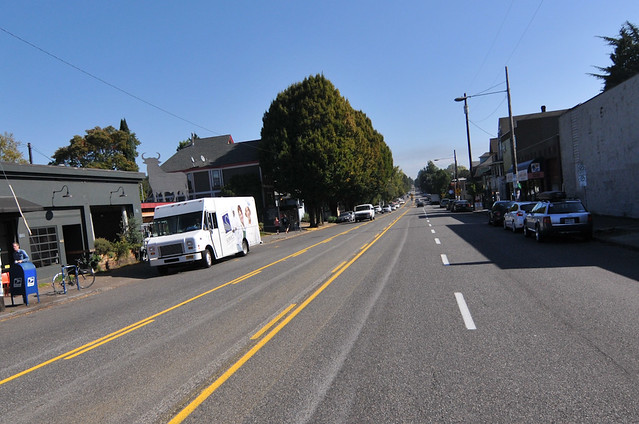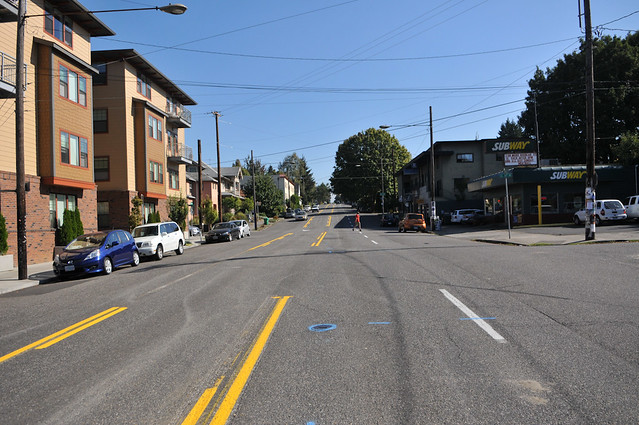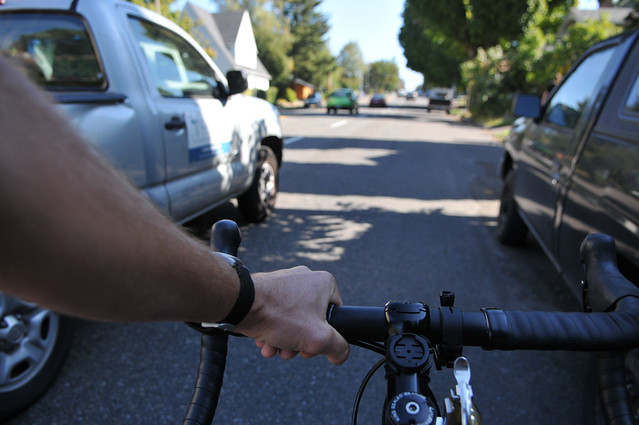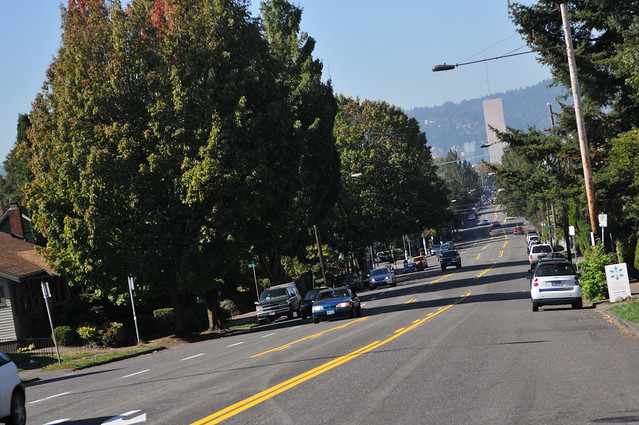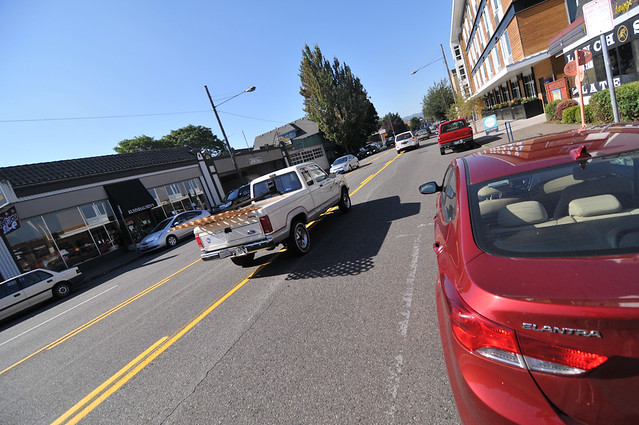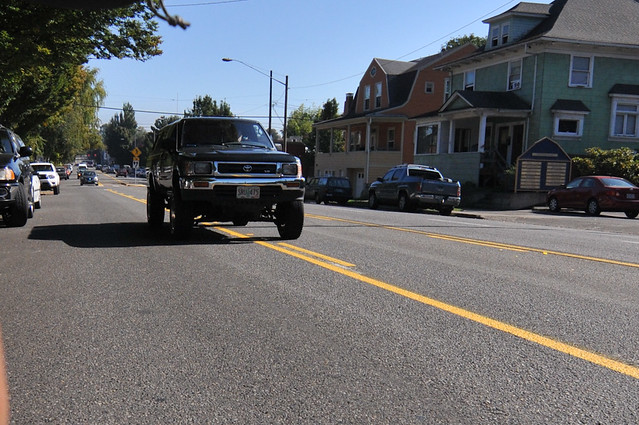
(Photos: J.Maus/BikePortland)
Saying that any removal of on-street parking during a redesign of East Burnside Street would have required more time and money than the city could afford, the Portland Bureau of Transportation is boosting on-street parking instead.
The East Burnside Transportation Safety Project between 14th and 32nd Avenues, part of the city’s high-crash corridor program, has converted one westbound lane west of 32nd into a center turn lane and converted the rush-hour-only lanes east of 32nd into permanent parking lanes.
For people who ride bicycles west on Burnside, one result is that space that often functioned as a de-facto bike lane — the curbside auto lane — has been eliminated.
Another factor: East of 32nd on Burnside, the city’s Bicycle Master Plan calls for “separated in-roadway” bike lanes to eventually be installed on Burnside east of 28th Avenue. Last weekend’s restriping makes the “pro-tem” (non-peak-hour) parking in that stretch permanent, meaning it’ll have to be removed again before bike lanes can be added.
The new plan also creates 15 new pro-tem and permanent curbside parking spaces between 14th and 30th.

(Click for a very large PDF of the bike plan map.)
On the other hand, crossing Burnside north and south by bike or foot is likely to be safer and more pleasant.
PBOT touts big safety benefit
It’s worth noting that this is a fairly dangerous stretch of road. Between 2002 and 2012, this stretch of Burnside saw 346 reported traffic crashes. At least 14 people were injured walking across Burnside on this stretch, and one was killed:
The city estimates that this project will reduce crashes by 30 percent by reducing lane changes, shortening crossing distances and slowing auto speeds. With longer estimated auto travel times and increased auto congestion, some drivers are likely to use Ankeny and Couch as cut-throughs. Both of those streets are popular bike routes. PBOT says they plan to make “Ankeny bikeway improvements” in spring 2015.
City: no room for new bike lanes
But why didn’t the city add bike lanes, as it usually does on safety-related road diets? Clay Veka, who managed the project for the city’s crash-reduction program, offered two reasons.
First, at current traffic volumes, traffic engineers calculated that removing an eastbound travel lane would have caused significant congestion. Here’s what they calculated traffic counts would look like, hour by hour, with only one standard travel lane in each direction plus a turn lane:
Second, assuming both eastbound lanes are needed, there’s no room for a bike lane on Burnside without removing at least one lane of auto parking. City officials decided “early in the public process,” Veka said, that this wouldn’t be possible without an extensive public process.
The city held open houses on these changes in spring and fall 2013.
“This is a safety project on a $120,000 budget with expected crash reduction of 30 percent,” Veka wrote in an email Friday, defending the decision to keep the high-crash corridor project quick and lean.
Advertisement
Veka also said the bike lanes wouldn’t be well connected to the rest of the city’s bikeway system.
“While there would be a good tie with the 20s bikeway, we didn’t have a tie-in to the east leg,” she wrote. “It was determined that we would move this project forward for the safety benefits and build it in such a way that wouldn’t preclude bike facilities in the future.”
What the new design looks like
Though Burnside is one of the city’s most important biking arteries east of 82nd Avenue, its bike lanes currently end at 68th Avenue before picking up again (in a couplet with Couch) west of Sandy. Burnside is, of course, a major commercial destination between Chavez and Martin Luther King Boulevard.
Jonathan rode the redesigned Burnside yesterday afternoon and captured photos of the new configuration:
As you can see, it’s possible for cars to pass westbound bikes by entering the turn lane. Next spring, the city will add crossing islands at 18th, 22nd and 24th, making passing a bit harder but probably reducing auto travel speeds.
Terry Dublinski-Milton, a biking advocate who participated in the public process, suggested in an email that bike lanes on Burnside weren’t seen as essential with two neighborhood greenways so close by.
“There is Couch and Ankeny one block over,” he said. “What WAS on the table from the beginning, and is still in the ‘may be funded’ stage, is an eastbound diverter for Ankeny to cut down on the traffic from 12th east. PBOT is waffling on this and really needs to be pushed.”
Still, he added, Metro’s Active Transportation Plan calculates that turning East Burnside into a bike route would have the best benefit/cost ratio of any street on the east side when it came to increasing bike traffic.
According to 2012 Census estimates, of the 73,057 Census tracts in the United States, the tracts running along Burnside in this stretch rank 38th and 149th for bike commuting. West of 28th Avenue, an estimated 20 percent of residents bike to work, while 35 percent drive. Between 28th and Chavez, it’s about 14 percent who bike and 48 percent who drive.
The Census doesn’t track the number of people who bike to other destinations such as the stores, eateries, venues and homes that line Burnside.





